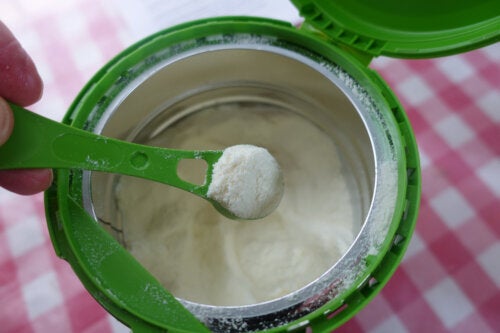Does Formula Contain All the Nutrients Babies Need?
Baby formula is a substitute for breast milk, but does it contain all the nutrients babies need? We'll tell you what you need to know.

Exclusive breastfeeding is the method of choice for feeding our children. But, sometimes, there’s no other way out but to substitute it totally or partially for milk formula. The reasons may vary, such as work, medical treatments, low milk production, or anatomical causes, among others. When this happens, the question that arises is whether these contain all the nutrients babies need.
Below, we’ll see what the experts tell us and we’ll check thoroughly to be sure if our children are well-fed with milk formulas. Remember that your child’s pediatrician will provide the indications and determine what’s best for the baby.
Read also: Formula Milk for Infants Six Months and Older: Is It Necessary?
What’s baby formula?
Baby formula is a food product whose formulation is based on cow’s milk and is intended for feeding the baby during the first year of life.
Formula milks are adjusted to the requirements of calories and nutrients proposed by international organizations. Each stage of a baby’s growth has its own requirements and the milk formula will change accordingly.
Types of milk formulas
These are the 2 types of formulas for each stage of a child’s growth:
- Starter formulas: These are formulas that are used from birth to 4 or 6 months of age, according to the pediatrician’s indications. It aims to imitate the composition of a mother’s milk.
- Follow-on formulas: Indicated from 4 or 6 months to one year of age. It’s meant to accompany the complimentary feeding introduced to the baby.
There are also growth formulas on the market for children from 1 to 3 years of age. In addition, there are other special formulas, which are elaborated to cover some problems of digestion, absorption, or intolerance to certain substances. These include formulas for premature infants, with added thickeners, lactose-free formulas, and those with modified proteins, among others.
Read also: Transient Lactose Intolerance in Children

Find out if baby formula contains all the nutrients for our children
Each woman produces the ideal milk for her child, and that’s why those formulations that come from cow’s milk must be modified in quality and quantity of nutrients. But how is each of them modified?
Calories
Milk formulas should provide 67 calories per 100 milliliters when prepared according to instructions. This value corresponds to that of breast milk. On the other hand, follow-on formulas, which complement the introduction of new foods, provide between 60 and 85 calories per 100 ml.
Proteins
The 3.5 grams of proteins contained in cow’s milk are reduced by between 1.2 and 1.8 grams when transformed into milk formula. The protein value of breast milk ranges from 0.9 to 1.1 grams per 100 ml. This reduction in solutes relieves the still immature renal load of infants.
The biological value of starter formulas also increases. Adding more whey protein to cow’s milk provides a higher content of essential amino acids, which will be used for infant growth. The Nutrition Committee of the Spanish Association of Pediatrics emphasizes that the whey protein/casein ratio should be 60/40.
In follow-on formulas, 85% of all protein is casein, at 2.4 grams per 100 milliliters. This moderately increases the solute load at the renal level, but the baby has the organic maturity to resolve this.
Fats
The percentage of fats between breast milk and cow’s milk doesn’t differ in quantity but it does differ in quality and absorption. The amount of fat added to the formula guarantees the contribution of 50% of the energy needed by the baby in the first 6 months of growth and development.
To improve the quality of fats, vegetable oils are added as sources of polyunsaturated fatty acids. Preferably, safflower, sunflower, soybean, and corn oils are used. The other thing that has received attention is omega-6 and omega-3. In the case of linoleic omega-6, there’s a limit, as formulas should contain between 0.2 to 0.8 grams per percent, with a ratio of 5 to 15 parts of linoleic to 1 part of linolenic omega-3.
This ratio will allow the baby’s body to produce other fatty acids that participate in its development. Such is the case of docosahexaenoic acid or DHA, a polyunsaturated fatty acid that’s related to good cognitive and visual development in newborns, according to a publication in the journal Global Nursing.
Carbohydrates
The cow’s milk used for milk formula should be enriched in lactose, as women’s milk contains almost twice as many carbohydrates. This carbohydrate functions as the main source of energy, promotes calcium bioavailability, and improves the baby’s intestinal health. After 6 months of age, formulas are mixed with solids of corn syrup, glucose, and, in some cases, sucrose.

Vitamins and minerals
Vitamins and minerals are in line with the amounts found in breast milk. The higher or lower proportion of some of them is monitored, as an imbalance may affect absorption and interaction with other minerals.
In the particular case of iron, as its values are low in breast milk, formulas are supplemented at no less than 1 milligram per 100 calories. When ascorbic acid is added, iron absorption improves significantly.
What do international experts say?
The journal Anales de Pediatria concludes that milk formulas are within the reference values for energy, protein, fat, and carbohydrate intake. However, micronutrients should be reviewed according to the current requirements of the infant and their adverse effects.
At the same time, follow-on formulas were reviewed by the Early Nutrition Academy, and their nutritional values were adjusted based on the baby’s maturation and the contribution of the diet after 6 months of age.
Breast milk is unique and fundamental
Milk formulas are elaborated with all the international controls to ensure the contribution of energy and nutrients to the growing baby. However, we reiterate that the bio-psycho-social and emotional relationship achieved with breast milk as the exclusive food during the first 6 months is unique. In this regard, it not only nourishes the baby but also prepares it for the future.

